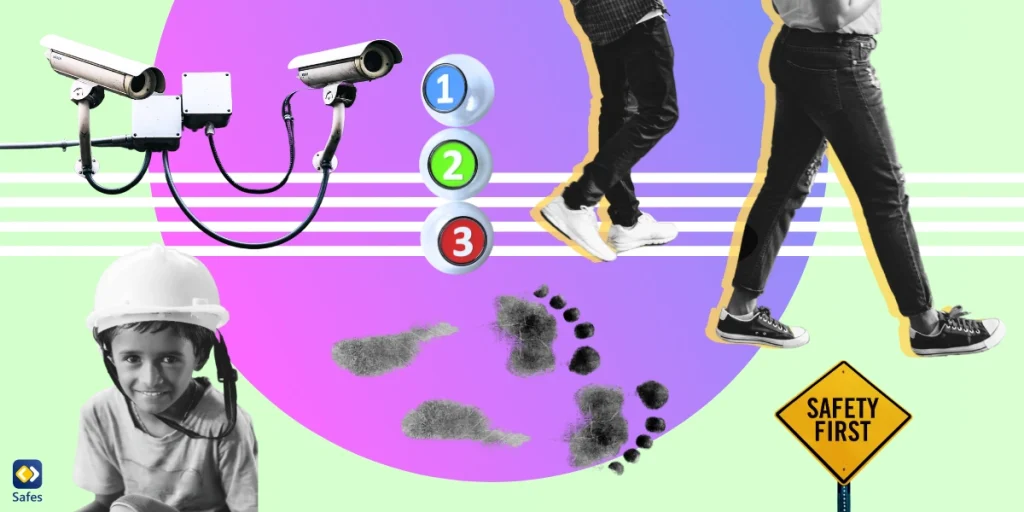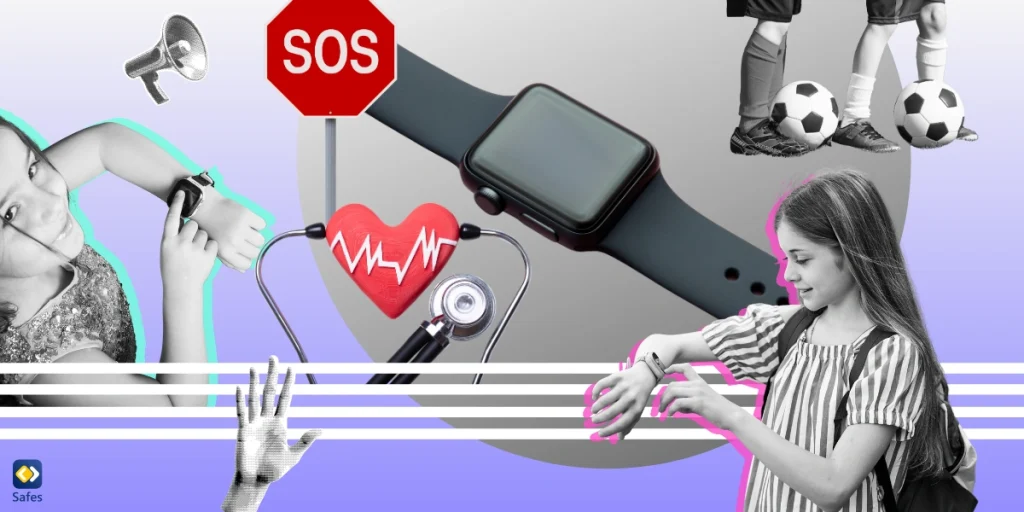Parents today face a variety of challenges in ensuring their children’s safety, especially with busy lifestyles and the ever-changing dynamics of modern society. Small tracking devices, such as mini GPS trackers, are tools initially designed to help locate lost items like keys, wallets, or luggage. However, their compact size and real-time tracking capabilities have made them increasingly popular among parents for keeping an eye on their children’s whereabouts. These devices aim to provide real-time location updates, offering parents a sense of reassurance in certain scenarios.
Download and Start Your Free Trial of the Safes Parental Control App
From backpacks to pockets, and even as wearable devices, small tracking devices are highly versatile. They are often marketed for their ability to help parents stay informed about their children’s locations, but how effective are they in achieving this goal?
How GPS Tracking Devices Work
Small GPS tracking devices rely on a combination of satellite signals and cellular networks to determine and share their location in real time. When paired with an app on your smartphone, these devices can send location updates to your Android device or iPhone, ensuring you always know where your child or their belongings are.
One standout feature of many of these apps is geofencing. This allows parents to set specific geographic zones and receive notifications when their child enters or exits these zones. For instance, a parent might get an alert when their child leaves school premises or arrives home, depending on the predefined geofences they’ve set.
Benefits of Using Mini GPS Trackers for Kids
Using small tracking devices for their children can have multiple benefits for parents.
Enhanced Safety
One of the key appeals of small tracking devices is their ability to provide real-time location updates, ensuring parents know where their child is at all times. Whether on their way to school, at a friend’s house, or attending an after-school activity, parents can receive updates that offer additional reassurance.
For parents with younger children or those with unique needs, these devices can serve as an extra layer of safety. For example, during vacations or in crowded public spaces, trackers can help locate a child quickly if they wander off.
Portability and Ease of Use
Small GPS tracking units are designed to fit seamlessly into your child’s daily life. Many devices can be clipped onto backpacks, tucked into pockets, or even worn as wristbands. Their small size and long battery life make them convenient and hassle-free for both parents and children.
Unlike traditional bulky GPS devices, mini tracking devices are lightweight, discreet, and easy to use. You won’t have to worry about your child feeling weighed down or irritated by the tracker.
Potential Drawbacks of Using Small Tracking Devices
Just like any other tech device, mini GPS tracking devices have some drawbacks as well, including:
Balancing Privacy and Independence
While small GPS tracking devices offer real-time location updates, they also raise significant privacy concerns. Some parents worry that constant monitoring could undermine their child’s sense of independence and strain the parent-child trust dynamic. In fact, research has shown how the shift in surveillance dynamics in the digital era affects how teens respond to parental control, highlighting growing concerns about privacy and the influence of constant digital monitoring on behavior.
Additionally, the discreet size of these devices makes them susceptible to misuse if they fall into the wrong hands. Furthermore, GPS trackers often store location data on servers, increasing the risk of data breaches. To mitigate these risks, parents should carefully review the privacy policies of any device or app they use and remain informed about how their child’s data is being managed.
Balancing Safety, Independence, and Trust
Another concern is the potential over-reliance on technology for ensuring safety. While mini GPS trackers can help locate a child in real time, they should not replace open communication or the teaching of essential safety practices. Relying solely on technology can create a false sense of security and overlook the importance of fostering situational awareness and trust.
Like any technology, small GPS tracking devices are not without flaws. Connectivity issues, battery depletion, and other technical limitations can render them unreliable at critical moments. Parents should view these devices as supplementary tools that enhance, rather than replace, foundational safety practices and ongoing communication with their children.
![]()
How to Choose the Right Mini GPS Tracking Device
When shopping for a small GPS tracking device, several factors should be taken into account:
- Battery Life: Devices with longer battery life reduce the need for frequent recharging.
- Durability: Durable models are ideal for active children who engage in outdoor activities.
- Features: Additional functionalities like geofencing, SOS buttons, and activity tracking may enhance the usefulness of the device.
- Compatibility: Ensure the device works with your preferred smartphone system, whether Android or iOS.
Popular Small GPS Tracking Devices on the Market
In case you’re thinking about getting a small tracking device for your child, you can think about these options:
Apple AirTags as Child Tracking Devices
While originally designed for locating items like keys or wallets, Apple AirTags have become a popular choice for parents seeking child tracking solutions. Using Apple AirTags as child tracking devices can be effective when attached to backpacks or shoes. However, their reliance on nearby Apple devices to update location may limit their real-time tracking capabilities.
Wearable Mini Trackers
Wearable GPS trackers, such as smartwatches with GPS capabilities, offer another level of convenience. But parents often ask, “Is the Apple Watch safe to wear?” The short answer is yes, but it’s worth exploring Apple Watch parental controls to ensure your child’s safety while using these devices.
Applications of Small Tracking Devices
Using tracking devices can be used in different occasions, including:
Tracking Cars and Belongings
Small tracking devices aren’t just for kids. Mini GPS trackers are excellent for tracking cars, helping parents keep tabs on teenage drivers or family vehicles. These devices can also be used to track items like luggage or bicycles, offering versatility beyond child safety.
Emergency Situations
In emergencies, a small GPS locator can be a lifesaver. If your child gets lost or separated from you in a crowded area, the tracker’s real-time location updates can guide you to them quickly. Many devices also feature an SOS button that your child can press to alert you immediately.
The Role of Apps in GPS Tracking and How Safes Can Help
The best location tracking apps enhance the functionality of small GPS tracking devices by providing user-friendly dashboards, alerts, and activity logs. These apps work seamlessly with mini GPS trackers to display real-time location updates, set geofences, and send notifications. Some apps even allow you to view historical data, giving parents valuable insights into their child’s daily movements—a feature particularly useful for busy families.
One standout example is Safes, a parental control app for both Android and iOS. Safes goes beyond basic location tracking, offering features like app usage monitoring, screen time limits, and detailed activity reports. It integrates effortlessly with mini GPS trackers to provide real-time updates and advanced parental controls. Whether you’re using Apple Watch parental controls or iPhone parental controls, Safes adds an extra layer of protection for your child.
For parents seeking a comprehensive solution, Safes is a powerful tool that combines GPS tracking with broader digital safety features. Try Safes today and experience peace of mind with a free trial!
![]()
Ethical Considerations of Using Tracking Devices
While small tracking devices might offer practical benefits, they also raise ethical questions about autonomy and trust. Some argue that constant monitoring might hinder a child’s ability to develop independence and decision-making skills. It’s important for parents to strike a balance between ensuring safety and respecting their child’s growing need for privacy and freedom. Open conversations about why the device is being used and how it works can help foster trust and ensure the child feels respected rather than controlled.
Alternatives to Small Tracking Devices
For parents who are hesitant about using GPS tracking devices, there are several non-technological alternatives to ensure their child’s safety. Open communication and teaching children essential safety practices, such as memorizing important phone numbers, understanding traffic rules, and recognizing safe adults to approach in emergencies, can empower kids to navigate their surroundings confidently.
Another option is establishing clear routines and check-in times, where children are expected to call or message their parents at specific intervals. Additionally, parents can encourage the use of buddy systems, where children travel or play in groups, reducing the risk of getting lost. For younger children, ID bracelets or tags with contact information can provide a simple yet effective safety measure.
While these alternatives may require more effort and trust, they can foster independence and responsibility in children without relying on technology.
Conclusion: Empowering Parents Through Technology
Small tracking devices present an opportunity for parents to stay informed about their children’s locations and overall safety. By understanding the benefits and limitations of these tools, parents can decide if they align with their family’s needs and lifestyle.
While these devices can offer added peace of mind, it’s important to view them as part of a broader safety strategy that includes open communication and teaching essential safety practices. Whether used for tracking children, belongings, or vehicles, small tracking devices are versatile tools that families can adapt to their unique requirements.
Your Child’s Online Safety Starts Here
Every parent today needs a solution to manage screen time and keep their child safe online.
Without the right tools, digital risks and excessive screen time can impact children's well-being. Safes helps parents set healthy boundaries, monitor activity, and protect kids from online dangers—all with an easy-to-use app.
Take control of your child’s digital world. Learn more about Safes or download the app to start your free trial today!



